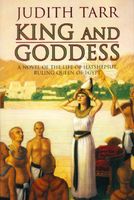- Welcome to FictionDB, Guest
- | My Account
- | Help

King & Goddess — Judith Tarr

A fictional portrait of Queen Hatshepsut, a woman who loved her land too much to see it in the hands of one weak king after another, describes how she made a commoner her chief servant, her architect, and her secret paramour, and how she became pharaoh of all Egypt.
Hatshepsut was the only daughter of Thutmose and his Great Royal Wife, and carried the King Right in her person. She was trained to govern, and loved her land and people above all other things. But custom and the Gods decreed that she must wed her half brother and be the Great Royal Wife while he reigned as Pharaoh. When her husband died, she should have stepped aside, allowing her husband's son by a concubine to rule over Egypt. But Hatshepsut was still young when her husband-brother died, and his heir was a mere child. The Temple of Amon gave the regency to her. And then Hatshepsut did the unthinkable - she took the crowns of Upper and Lower Egypt in her own name and made herself king. Until the twentieth century, the life of Hatshepsut was veiled in mystery. After her death, the nephew whose throne she usurped had taken his revenge in a peculiarly Egyptian way: He eradicated her names from the annals of Egypt, chiseled them off every monument, destroyed every statue he could find, dispersed the goods of her tomb, and hid her nameless mummy. He tried to hide her from history forever. But buried deep in the rock beneath a lovely temple lay the tomb of the architect Senenmut - Hatshepsut's secret lover. And in his tomb was found the history of Hatshepsut, images of her, and the story of a lifelong love that Senenmut could reveal only in death. Judith Tarr has built from Senenmut's true account a novel of great power, about a queen who loved her land too much to see it in the hands of a weak king, and about a woman whose passion for ruling was stronger than her love for one man.
Hatshepsut was the only daughter of Thutmose and his Great Royal Wife, and carried the King Right in her person. She was trained to govern, and loved her land and people above all other things. But custom and the Gods decreed that she must wed her half brother and be the Great Royal Wife while he reigned as Pharaoh. When her husband died, she should have stepped aside, allowing her husband's son by a concubine to rule over Egypt. But Hatshepsut was still young when her husband-brother died, and his heir was a mere child. The Temple of Amon gave the regency to her. And then Hatshepsut did the unthinkable - she took the crowns of Upper and Lower Egypt in her own name and made herself king. Until the twentieth century, the life of Hatshepsut was veiled in mystery. After her death, the nephew whose throne she usurped had taken his revenge in a peculiarly Egyptian way: He eradicated her names from the annals of Egypt, chiseled them off every monument, destroyed every statue he could find, dispersed the goods of her tomb, and hid her nameless mummy. He tried to hide her from history forever. But buried deep in the rock beneath a lovely temple lay the tomb of the architect Senenmut - Hatshepsut's secret lover. And in his tomb was found the history of Hatshepsut, images of her, and the story of a lifelong love that Senenmut could reveal only in death. Judith Tarr has built from Senenmut's true account a novel of great power, about a queen who loved her land too much to see it in the hands of a weak king, and about a woman whose passion for ruling was stronger than her love for one man.
Genres
Sub-Genres
Click on any of the links above to see more books like this one.




